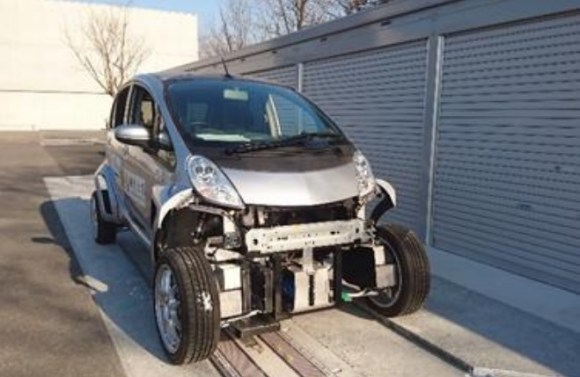
The Wireless IWM Unit 2 turns a flaw of a electric vehicles into a strength, opening a world of possibilities.
● Electric Vehicles
Since the dawn of the horseless carriage, engineers have been designing cars powered by electricity. But time and time again they could never overcome the raw power offered by the combustion engine. Even today with an environmental calamity at our doorstep, we’ve only gone as far as embracing hybrid vehicles.
The main problem with electric vehicles (EVs) is kind of like the ending sequence of The Flinstones. Fred needs power to keep kick-running his car long distances but to get that power he needs to eat a rack of brontosaurus ribs so big that it tips over the entire car – with mildly amusing results.
In much the same way, electric cars need more and bigger batteries to get enough power to rival the distance gas-powered ones get on a single charge/fill-up. But too big a battery will just weigh them down too much so they would need even more power to move.
Improvements in battery technology have come a long way and are continuing to get better at a rapid pace, but people still don’t seem to be jumping on the EV bandwagon in large numbers yet.
Perhaps what the EV market needs is a whole new type of car which, rather than tries to catch up to the mileage of combustion engine automobiles, surpasses it in every way.
Now, a research group in Japan thinks they may have something.
● In-Wheel Motors
This new vehicle is called the Wireless IWM Unit 2 where IWM stands for “in-wheel motor.”
Most cars on the market use a transmission system where a central engine delivers power to two or four of the wheels through a series of gears and rods. Without getting too technical, in the diagram below, the long thing labeled “torque tube” is turned by the engine and then turns a bunch of doohickeys which then turn the rods that turn the wheels.
Standard transmission systems have their share of weaknesses. All of those turning gears and rods means a fair bit of power is lost and considerable weight is added to the car. Because of their high power, this isn’t big issue for combustion engine cars, but for electric vehicles it’s a huge setback. On the other hand, in-wheel motors have an engine contained right inside the wheel so the maximum power is applied directly.
▼ The rear in-wheel motor of a Honda FCX prototype
Much like electric cars, the concept of in-wheel motors have been around from the very start of automobile manufacturing. One of the most notable examples was the Lohner-Porche Mixte Hybrid from 1900.
▼ These guys rocking a Mixte Hybrid surely had to beat
the women away with a hoop trundling stick.
In-wheel motors were and are superior in many ways, mainly by providing considerably better handling and acceleration making them safer and more comfortable than cars with a transmission. But slapping four combustion engines into such a tiny space simply wasn’t practical, so the in-wheel motor was relegated to bikes, lunar rovers, other types of machinery, and concept cars.
● Wireless IWM Unit 1
In recent years there has been renewed interest in in-wheel motors with the current push for better electric cars. Using them eliminates the need for a bulky transmission and can reduce the weight of the drive unit by 30 to 40 percent. Still, one issue has been that the electricity must be delivered to the wheel from a battery via wires.
▼ The Luka EV is a groundbreaking machine in that it both effectively
utilizes in-wheel motors and is actually a good looking EV.
Given all the rapid spinning along with the wear and tear that the underside of an automobile goes through, entrusting the power of each wheel to cables is risky. So a team of researchers with the University of Tokyo, the systems engineering firm Toyo Denki, and the mechanical engineers at NSK set out to create a wireless in-wheel motor automobile to completely eliminate the risk of breakage.
The Wireless IWM Unit 1 was a success and could efficiently transmit electric power from a central battery to each wheel’s motor without any wires, allowing for smoother and safer movement.
They also utilized “electric road” technology wherein the roads are paved with coils embedded that can wirelessly charge the car’s battery as it drives along. A coil receiver on the bottom of the frame would receive the charge and store it in the battery.
● Wireless IWM Unit 2
However the research group realized that a major weakness of the Wireless IWM Unit 1 was that it followed the power distribution system of regular EVs when it had the potential to be even better.
Rather than relying on a central battery, they fitted each wheel’s motor with another coil to receive the charge provided from electric roads. With this added boost, electric cars can get even more distance out of a single charge, provided there are electric roads.
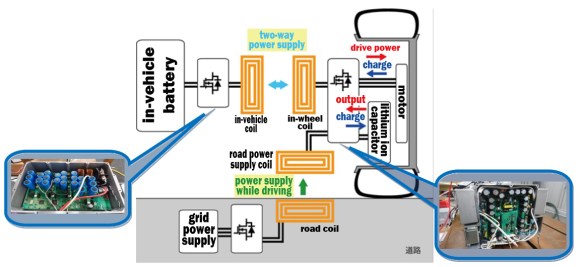
Toyo Denki (edited by RocketNews24)
This diagram shows how the Wireless IWM Unit 2 works. The in-wheel motor receives electricity from both the battery in the body of the car and from the power grid through coils in the road. The motor will consume power from the road as needed and any excess electricity will be redirected to the charge the main battery. If the car goes off an electric road, then it will use the power of the battery like a regular EV would. As a result, it can travel much farther on a single battery charge.
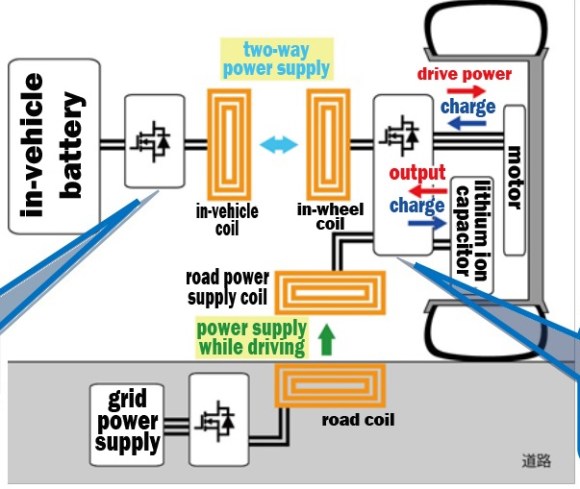 Toyo Denki (edited by RocketNews24)
Toyo Denki (edited by RocketNews24)
Or to put it in Flintstones terms, rather than Fred getting fat off a huge rack of ribs, he can eat a sensible steak and then pick up Fruity Pebbles from the street as he drives either to eat straight away or keep in his pocket for later, thus keeping his weight down and sustaining his energy enough even to participate in the Indianrockolis 500 under the alias Goggles Paesano.
▼ Whether or not we’ll be able to drive on
walls in real life, however, remains to be seen.
With that said, it will still take a lot of different factors coming together for this technology to become widely used, the most important of which would be the installation of electric roads. Sweden and South Korea have both opened stretches of electric roads, but there are construction, operation, and maintenance costs.
But as more designs like the Wireless IWM Unit 2 emerge, the concept of electric roads becomes more attractive and more possibilities open up. Soon the world may finally have an electric car that not only rivals combustion engine ones, but surpasses them.
Source: Toyo Denki, NSK
Top image: Toyo Denki

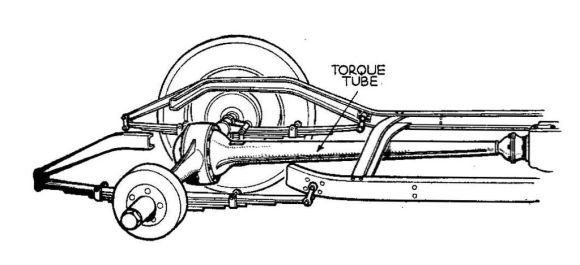
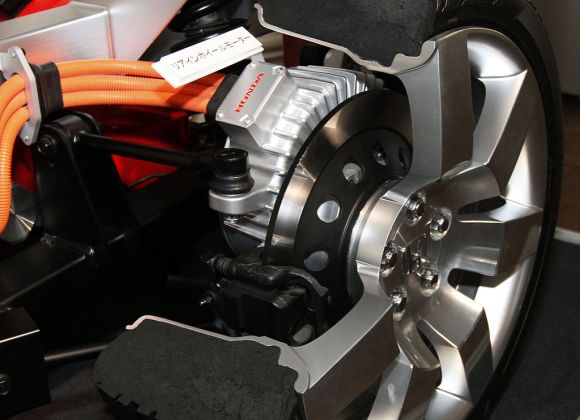
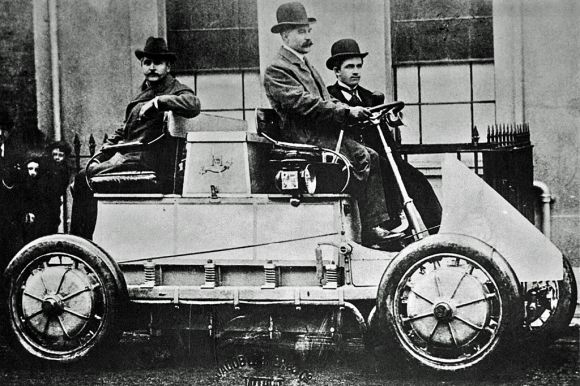
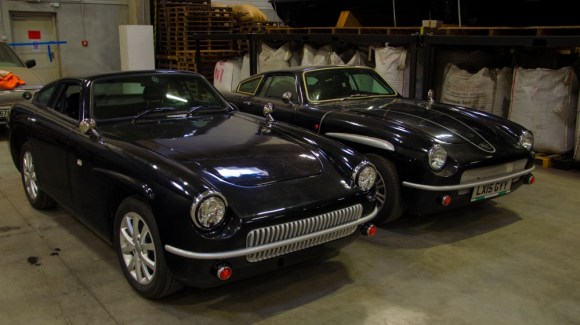
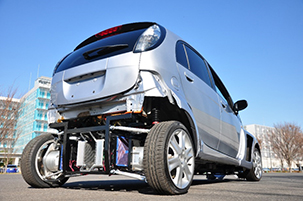
 Breathe easy – Toyota redesigning Prius plug-in hybrid to double car’s all-electric range
Breathe easy – Toyota redesigning Prius plug-in hybrid to double car’s all-electric range The most fun I’ve had behind the wheel this year was with Toyota’s unusual vision for the future of mobility
The most fun I’ve had behind the wheel this year was with Toyota’s unusual vision for the future of mobility A self-driving car that delivers ramen is Nissan’s newest automotive innovation【Video】
A self-driving car that delivers ramen is Nissan’s newest automotive innovation【Video】 Super compact, foldable electric motorcycle soon to be available in stores in Japan
Super compact, foldable electric motorcycle soon to be available in stores in Japan This Chinese Tesla killer has a fish tank in the back seat!
This Chinese Tesla killer has a fish tank in the back seat! All-you-can-drink Starbucks and amazing views part of Tokyo’s new 170 meter-high sky lounge
All-you-can-drink Starbucks and amazing views part of Tokyo’s new 170 meter-high sky lounge McDonald’s new Happy Meals offer up cute and practical Sanrio lifestyle goods
McDonald’s new Happy Meals offer up cute and practical Sanrio lifestyle goods Mister Donut ready to make hojicha dreams come true in latest collab with Kyoto tea merchant
Mister Donut ready to make hojicha dreams come true in latest collab with Kyoto tea merchant Studio Ghibli glasses cases let anime characters keep an eye on your spectacles
Studio Ghibli glasses cases let anime characters keep an eye on your spectacles The oldest tunnel in Japan is believed to be haunted, and strange things happen when we go there
The oldest tunnel in Japan is believed to be haunted, and strange things happen when we go there Randomly running into a great sushi lunch like this is one of the best things about eating in Tokyo
Randomly running into a great sushi lunch like this is one of the best things about eating in Tokyo Starbucks reopens at Shibuya Scramble Crossing with new look and design concept
Starbucks reopens at Shibuya Scramble Crossing with new look and design concept Beautiful Sailor Moon manhole cover coasters being given out for free by Tokyo tourist center
Beautiful Sailor Moon manhole cover coasters being given out for free by Tokyo tourist center More foreign tourists than ever before in history visited Japan last month
More foreign tourists than ever before in history visited Japan last month Hamster abandoned at Tokyo ramen restaurant gets new home
Hamster abandoned at Tokyo ramen restaurant gets new home Disney princesses get official manga makeovers for Manga Princess Cafe opening in Tokyo
Disney princesses get official manga makeovers for Manga Princess Cafe opening in Tokyo Beautiful new Final Fantasy T-shirt collection on the way from Uniqlo【Photos】
Beautiful new Final Fantasy T-shirt collection on the way from Uniqlo【Photos】 Is the new Shinkansen Train Desk ticket worth it?
Is the new Shinkansen Train Desk ticket worth it? Foreign English teachers in Japan pick their favorite Japanese-language phrases【Survey】
Foreign English teachers in Japan pick their favorite Japanese-language phrases【Survey】 Japanese convenience store packs a whole bento into an onigiri rice ball
Japanese convenience store packs a whole bento into an onigiri rice ball We try out “Chan Ramen”, an underground type of ramen popular in the ramen community
We try out “Chan Ramen”, an underground type of ramen popular in the ramen community Studio Ghibli releases Kiki’s Delivery Service chocolate cake pouches in Japan
Studio Ghibli releases Kiki’s Delivery Service chocolate cake pouches in Japan Japan’s bone-breaking and record-breaking roller coaster is permanently shutting down
Japan’s bone-breaking and record-breaking roller coaster is permanently shutting down New definition of “Japanese whiskey” goes into effect to prevent fakes from fooling overseas buyers
New definition of “Japanese whiskey” goes into effect to prevent fakes from fooling overseas buyers Our Japanese reporter visits Costco in the U.S., finds super American and very Japanese things
Our Japanese reporter visits Costco in the U.S., finds super American and very Japanese things Studio Ghibli unveils Mother’s Day gift set that captures the love in My Neighbour Totoro
Studio Ghibli unveils Mother’s Day gift set that captures the love in My Neighbour Totoro Foreign passenger shoves conductor on one of the last full runs for Japan’s Thunderbird train
Foreign passenger shoves conductor on one of the last full runs for Japan’s Thunderbird train Domino’s Japan now sells…pizza ears?
Domino’s Japan now sells…pizza ears? New Japanese KitKat flavour stars Sanrio characters, including Hello Kitty
New Japanese KitKat flavour stars Sanrio characters, including Hello Kitty Kyoto creates new for-tourist buses to address overtourism with higher prices, faster rides
Kyoto creates new for-tourist buses to address overtourism with higher prices, faster rides Sales of Japan’s most convenient train ticket/shopping payment cards suspended indefinitely
Sales of Japan’s most convenient train ticket/shopping payment cards suspended indefinitely Sold-out Studio Ghibli desktop humidifiers are back so Totoro can help you through the dry season
Sold-out Studio Ghibli desktop humidifiers are back so Totoro can help you through the dry season Japanese government to make first change to romanization spelling rules since the 1950s
Japanese government to make first change to romanization spelling rules since the 1950s Ghibli founders Toshio Suzuki and Hayao Miyazaki contribute to Japanese whisky Totoro label design
Ghibli founders Toshio Suzuki and Hayao Miyazaki contribute to Japanese whisky Totoro label design Doraemon found buried at sea as scene from 1993 anime becomes real life【Photos】
Doraemon found buried at sea as scene from 1993 anime becomes real life【Photos】 Tokyo’s most famous Starbucks is closed
Tokyo’s most famous Starbucks is closed One Piece characters’ nationalities revealed, but fans have mixed opinions
One Piece characters’ nationalities revealed, but fans have mixed opinions We asked a Uniqlo employee what four things we should buy and their suggestions didn’t disappoint
We asked a Uniqlo employee what four things we should buy and their suggestions didn’t disappoint Princesses, fruits, and blacksmiths: Study reveals the 30 most unusual family names in Japan
Princesses, fruits, and blacksmiths: Study reveals the 30 most unusual family names in Japan South Korean shipyard workers wear robo-suits for super-strength
South Korean shipyard workers wear robo-suits for super-strength Nissan unveils the world’s first “Intelligent Parking Chair”【Video】
Nissan unveils the world’s first “Intelligent Parking Chair”【Video】 Tokyo Motor Show set to reveal the new concept Toyota SF-R, which looks surprisingly like Pikachu
Tokyo Motor Show set to reveal the new concept Toyota SF-R, which looks surprisingly like Pikachu Toyota’s hydrogen fuel cell powered car ready for sale this December
Toyota’s hydrogen fuel cell powered car ready for sale this December Toyota’s new concept is more high-tech horse than car
Toyota’s new concept is more high-tech horse than car Toyota proposes a future where cars become pizza shops, hotels, and occasionally cars too
Toyota proposes a future where cars become pizza shops, hotels, and occasionally cars too Now you can request a Tesla when you Uber in Japan with their new Premium EV option
Now you can request a Tesla when you Uber in Japan with their new Premium EV option Japanese Twitter users and the tale of the broken battery
Japanese Twitter users and the tale of the broken battery Anime-style magic circle cordless charging pad is the coolest way ever to charge a phone【Video】
Anime-style magic circle cordless charging pad is the coolest way ever to charge a phone【Video】 Lexus pays homage to its Japanese workers by building a driveable origami car out of cardboard
Lexus pays homage to its Japanese workers by building a driveable origami car out of cardboard Five beautiful pylon designs that belong in Japan
Five beautiful pylon designs that belong in Japan China is trying to build an empire of electric cars—but the strategy has one huge flaw that will benefit Tesla
China is trying to build an empire of electric cars—but the strategy has one huge flaw that will benefit Tesla Yamaha gives us a glimpse into the future of transport with two awesome new mobility vehicles
Yamaha gives us a glimpse into the future of transport with two awesome new mobility vehicles The sad story of this painfully nerdy anime itasha will make your heart AND eyes hurt【Photos】
The sad story of this painfully nerdy anime itasha will make your heart AND eyes hurt【Photos】 Synthetic fossil fuels made from light, water, and CO2 in the air tested in Osaka
Synthetic fossil fuels made from light, water, and CO2 in the air tested in Osaka Honda readying a Fuel Cell Vehicle for buyers next year, just in time to challenge Toyota
Honda readying a Fuel Cell Vehicle for buyers next year, just in time to challenge Toyota
Leave a Reply